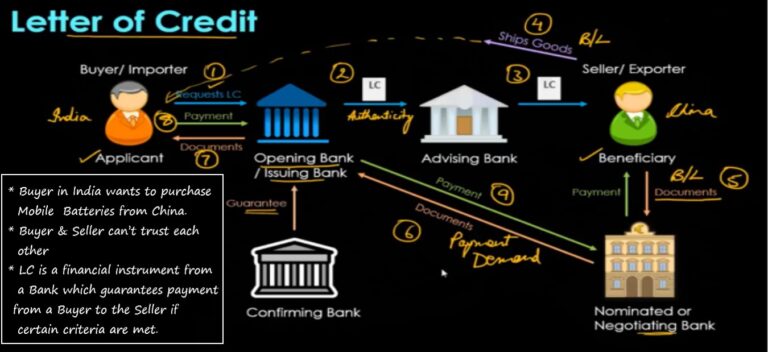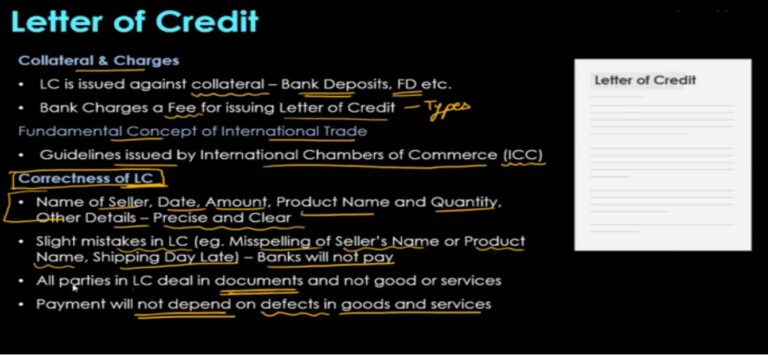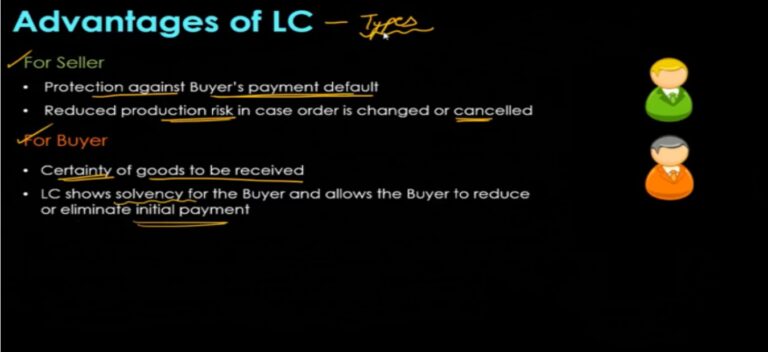What is LC? (Letter of Credit)

Hi! My name is Nipun Bansal and m running my Export Import Business from Delhi, India. I am going to share my knowledge about Exim business. I will continue posting more guidance and that will help you to start your own Exim Business with a very low investment.
The process of shipping goods in India, whether you’re an importer or exporter, can be complex and frustrating to navigate without the right information. With this guide on how to import and export goods in India, we’ll provide you with everything you need to know to get your goods from point A to point B—or anywhere else around the world! You’ll learn about shipping via air freight, sea freight, and courier; how import and export duties work; where to store goods before they reach their final destination; tips for shipping time-sensitive items like food or medicine; and much more! So Keep Reading my Blogs . Thank you!
Letter of Credit(LC) का सब कुछ आसान भाषा में समझिये
Biggest risk in export import business is “PAYMENT”.
Everyday we are getting news about ban on Export Import by neighbouring countries. Nepal, Srilanka, Indonesia, Myanmar etc have banned several items and impact is not only with India. Whole world is facing crisis situation. Anytime orders can be halted and payments can stuck. Impact and losses can be very high which can’t be afforded by small and medium EXIM business owners. So the question is “How to avoid Risk”? Answer is “Letter of Credit”
Many friends have requested to make a detailed blog about the letter of credit. In this blog, we will understand the concept “Letter of Credit” And we’ll see how this works.
Letter of credit, like a bank guarantee, is a non-fund based credit facility. But this is different than that, many people get confused. They consider bank guarantee and letter of credit the same. But these are two different financial instruments and their purpose is also different. For example, you are a buyer and you want to purchase something from the seller and he may not be in the city. He lives far away from you or he may not be in your country. Let’s say you live in India and you want to import Mobile Batteries from China. So in this case, it will be very difficult for you to trust the seller and it is difficult for the seller to trust you. You may not have funds to transfer immediately. The seller will not send goods without money and you will also not give money without taking goods. Then, in this case, the third party is used, banks are used 2 or 3 banks are involved in this concept. So, in what ways is this credit facility is used or arranged? Lets discuss detail, please read the entire blog carefully So that you’ll understand this concept nicely.
So let’s understand what is a letter of credit? & How does this process work?
We will take the same example which we took in the starting. Assume you are a buyer in India and you want to import mobile batteries from China Then you cannot trust one another, the buyer and seller cannot trust each other. The buyer will think that, if I send the money first then maybe I’ll not get the goods on time. Seller may think that his payment will not be on time. So in these cases, the letter of credit is very useful which is a financial instrument, a bank issues it. There is a guarantee in a way through this financial instrument, That a buyer will pay the seller and The banks pay the amount as soon as the criteria meet. So the seller has to meet the criteria, to ship goods and present the document to the bank.

Here you can see in picture, I have done color coding with different colors. Here you can see the movement of LC in blue color. LC was requested and then LC was issued. It is called the opening of LC. So the opening bank is who opens the LC. Then the LC has reached the advising bank and then it is reached to the seller. After that, the movement of the documents is marked by the orange color. First, it reaches the negotiating bank, after that to opening bank n After that, it reached the applicant. Payment is being made from the applicant to the opening bank. After that, to the negotiating bank, and negotiating bank has already made the payment to the beneficiary.
So how this process is operated? & How are the banks are involved?
Let’s understand! Firstly the buyer becomes the applicant in a way because he will issue the letter of credit.
Beneficiary means the seller.
Ist Step, the applicant will go to his bank and the bank to which he will request the letter of credit We call it opening bank or issuing bank. So he will request a letter of credit there. This is the first part of this In the next step, there is an advising bank which is a bank of the beneficiary.
The opening bank will send the letter of credit to the advising bank In our second step.
2nd Step, The letter of credit will reach the advising bank.
Then the advising bank will check the authenticity here In authenticity, he will check all the things whether the name is correct or not, Product name and all these things will be checked in the letter of credit.
3rd Step, Then advising bank will send that letter of credit to the seller. Now the seller has full trust, there is a build-up trust Because the buyer has sent the letter of credit. That means he is very serious about it. After that, he will ship the goods from here. Letter of credit in a way built trust that his money is not going anywhere, I’ll get the money for sure Because the banks are involved here.
4th Step, these goods will be shipped. These are in route, let’s say these are only shipped, they haven’t reached the buyer yet Because it will take time to reach from China to India. But this process of documents will go on. After that, the seller will get a bill of lading here Bill of lading is the main document when goods are exported from any country.
5th Step, Seller will take the bill of lading to the nominated or negotiating bank. A nominated or negotiating bank can be a separate bank or advising bank, Both can be the same and negotiating bank can be a separate bank. The purpose of negotiating bank is to check the shipping documents.
The bill of lading present in here, they will check its accuracy of the goods are shipped properly or not, according to LC. After this, the negotiating bank or the nominated bank will make the payment to the beneficiary. So the payment to the beneficiary is done here.
Huuufff Relief and safe.
6th Step, negotiating bank sends the documents to the opening bank And demand the payment.The opening bank will send these documents to the applicant and will take his approval if all the documents are right or not. The products that they have ordered are shipped according to them or not. Once the applicant’s approval comes, the opening bank demands the payment from applicant and applicant make payment to the opening bank.
7th Step, After approval, the applicant has done the payment to the opening bank.
8th Step, After that, the opening bank again makes the payment to the negotiating bank on the.
As I have already told you that the negotiating bank and advising bank can be the same. So in this way, this whole process works and the goods that have been shipped here will be delivered. So the buyer will get his goods and the seller will get his payment. The whole transaction would end and the trust issue will be resolved. Many times one more step get involved. Many times the advising bank thinks that the credit rating of the opening bank isn’t that great. Maybe this is a small bank. Then it says that bring the guarantee from a bank that has good credit ratings. If a big bank guarantees you then you shouldn’t have a problem In issuing Letter of credit for opening bank. If opening bank, in any case, defaults the letter of credit then it will be your guarantee and it will be liability of the confirming bank for the payment. So in this way, another bank, confirming bank can be involved.
So this was the working of letter of credit.

We will talk about the collateral and charges When a bank issues LC, then it issues it against the collateral. Whatever the opening or issuing bank is Collateral means keeping the bank deposits or FD as a security. The bank always charges a fee to issue a letter of credit. The fees are dependent on the type of letter of credit. I will cover the types of letters of credit in the next blog, So make sure to read my next blog. This is a fundamental concept of international trade. Because buyers and sellers do not know each other in international trade As I have told you earlier, there are trust issues and that’s why international guidelines are issued.
International Chambers of Commerce issues guidelines for a letter of credit also. So ICC is its main body. After that, the correctness of LC is very important. I am highlighting it because in LC there’s only the exchange of documents, Goods and services are not exchanging there. The contents given in the LC is very important, What is the name of the seller, exact issuing date, What is the exact amount of the letter of credit, What is the product name and quantity, What are other details, they should be precise and clear. There should not be spelling mistakes If there is any kind of minor mistake, The name of the seller has missed “X” Or there is “Y” in place of “X”, If the product name has not been written properly, If the name is written half or shipping has not been done on time. The shipping date is written on the document, however the shipping was not done on that date. So for these minor things too, the bank will not pay according to LC rr we have to make a new LC.
All parties in LC deal in the document and not goods and services. As you have read that I explained the whole process and there is only a process of document. Banks do not care about goods and services. So basically if the documents are right then the payment will be done. Payment will not depend on whether there is a defect in goods or services.
Important for bank is if the documents are right then the bank will do the payment. There is no guarantee for if the goods are defective or the whole goods are not delivered. So this is not the liability of the bank. This problem will be solved by the buyers and sellers In whatever ways they want to resolve it.
So it is very important that if you are a buyer then you must check all the spellings in the letter of credit and check all the details in advance before bank issue LC. And as a seller also you would check all the details In the letter of credit Before that, you should not ship the goods.

Now we will discuss what are the advantages of a letter of credit For a buyer or the seller.
First, we will discuss about the seller As we have discussed, that we get protection If the buyer does payment default then it is the liability of the bank. Bank will surely pay you after that your production risk decreases. Assume if it is suddenly canceled but if the letter of credit has been issued already then the buyer cannot do anything, he’ll have to buy goods from you.
We will discuss about the buyer What advantages do buyers have? The goods will be received by you timely. So there’s a certainty that you will surely receive goods. After that, LC shows your solvency that you are in business and in a way, it is showing standing in your business because the bank is ready to take credit risk on you. After that, you get a small credit you don’t have to do an initial payment. So it reduces the burden. Assume if you don’t have immediate payment then you get time. I think I have covered all the major points related to LC how the whole mechanics works, What are the important features of the letter of credit and what are the advantages of a letter of credit to the buyers and sellers.